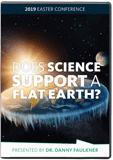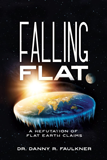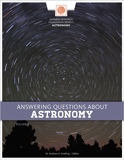
Is Light a Wave or a Particle? What Do Flat-Earthers Say?
Analyzing a debate among flat-earthers
Several speakers at the first Flat Earth International Conference in 2017 mentioned that there was much division among flat-earthers. The speakers were unanimous in their pleas for peace and unity between flat-earthers. At that time, I was in my second year of researching the flat-earth movement, but this was news to me. As it turns out, the division primarily was some flat-earthers denouncing others for being shills, sellouts, or paid controlled opposition. I suppose I was clueless about this conflict because I was more interested in the substance of flat-earthers’ claims and not so much personality clashes. At least one prominent flat-earther who was the recipient of some of this abusive treatment eventually left the movement.
Over the past five years, I’ve taken notice of more substantive differences that have arisen among flat-earthers. For instance, all flat-earthers discount gravity. It’s not that flat-earthers deny the inclination of objects to fall downward. Rather, when they say they don’t believe in gravity, they refer to the conventional scientific understanding of gravity, such as Newton’s law of gravity or general relativity. As to why things tend to go downward, flat-earthers generally fall into two camps: attributing it to buoyancy and density, or saying it is an electromagnetic phenomenon. To people who have a deep understanding of physics, neither of these proposals makes sense. Such disagreements among flat-earthers can get very heated. I think a component of these clashes is ego. I suspect that many of the denouncements thrown back and forth are driven by an attempt to generate a following, sometimes motivated by donations they hope to get from their fans.
Currently, there is a war going on between two groups of flat-earthers over the nature of light: is light a wave or a particle? Austin Whitsitt (a person I have discussed in a previous blog, though only by his first name) is the primary defender of the wave theory. The primary proponent of the particle side is John Stunja (aka Quantum Eraser, aka QE), someone I have discussed in several previous blogs. The two have squared off in recent live programs on their respective YouTube channels. I have heard them briefly interact over this on FE 24/7, a flat-earth channel that I listen to from time to time. But other than that, I am not aware of a direct confrontation between the two.
In This Corner: Light Is a Wave
Austin insists that since light is a wave, there must be an aether. It’s not clear what Austin means by aether. Most people understand aether to be the nineteenth century concept of a mechanical medium for light that permeates space. But a series of experiments in the second half of the nineteenth century ruled out all versions of this classical aether theory. At points, Austin seems to allude to electromagnetic field theory developed by James Clerk Maxwell. A century and a half ago, Maxwell published four vector calculus equations that describe all electromagnetic phenomena. Solving Maxwell’s four equations simultaneously results in vibrations of mutually perpendicular electric and magnetic fields with a wave propagating perpendicular to the plane of the electric and magnetic fields. The computed speed of this wave exactly matches the measured speed of light. This was an astonishing result. Maxwell had set out to unify electricity and magnetism into a single theory, which he successfully did. He did not attempt to find the true medium of light—that surprisingly fell out of his work as a bonus. In retrospect, this was a much more satisfactory medium for light, but it took years for physicists to give up on a mechanical medium. Perhaps electromagnetic fields are the aether that Austin has in mind. If so, he would be better served not calling Maxwell’s fields aether, because that term is associated with the now-discarded notion that a mechanical medium fills space, and the electromagnetic field model definitely is not a mechanical medium.
But Austin is not out of the woods in this, for he also rails against Einstein’s theory of special relativity. Austin is unaware that Maxwell’s theory is the foundation of special relativity. The title of Einstein’s revolutionary 1905 paper on the special theory of relativity was “On the Electrodynamics of Moving Bodies.” To most people, that sounds like an odd title for a paper on special relativity. Einstein developed an idea originated by Henri Poincaré. Poincaré noted that electrodynamic phenomena are invariant with respect to inertial reference frames. Since Maxwell had demonstrated that light is an electromagnetic phenomenon, then it follows that light, and more specifically, the speed of light, must also be invariant with respect to inertial reference frames. This is what the Michelson-Morley experiment and the many other aether experiments in the late nineteenth and early twentieth centuries had shown. It also is the foundation of Einstein’s theory of special relativity. Therefore, special relativity follows directly from classical electromagnetic theory, though Austin doesn’t appear to know that. Later, Einstein developed the general theory of relativity to better explain gravity. Together, special relativity and general relativity form one of the twin pillars of modern physics.
And in This Corner: Light Is a Particle
Quantum mechanics is the other pillar of modern physics, and this is where John Stunja comes in. As I’ve noted before, John fashions himself to be a master of many scientific concepts, particularly those of modern physics (as indicated by his chosen internet moniker, Quantum Eraser). On the road to laying the foundation for quantum mechanics in the late nineteenth century, there were some important experiments that suggested light has a particle nature. John likes discussing some of those experiments. But he conveniently avoids the experiments, done about the same time, that suggested particles, such as electrons, exhibit a wave nature too. He also omits discussion of experiments in which light exhibits a wave nature.
John builds all his arguments by selectively using definitions and quotes from many different sources (Austin also does this, albeit a little less so). John uses quotes by famous physicists to argue that light must be a particle. However, if he continued to look just a bit more, I’m sure he would find many of his chosen sources also give the wave side of light too. They aren’t that difficult to find. For instance, the following is from the textbook I used in my general physics class the last year I taught at the university.1
We have studied many examples of the behavior of light and other electromagnetic radiation. Some, including the interference and diffraction effects described in Chapter 35 and 36, demonstrate conclusively the wave nature of light. Others, the subject of the present chapter, point with equal force to the particle nature of light. At first glance these two aspects seem to be in direct conflict. How can light be a wave and a particle at the same time?
We can find the answer to this apparent wave-particle conflict in the principle of complementarity, first stated by the Danish physicist Niels Bohr in 1928. The wave descriptions and the particle descriptions are complementary. That is, we need both to complete our model of nature, but we will never need to use both at the same time to describe a single part of an occurrence.
Or consider this from a textbook used in a modern physics course I took while an undergraduate student.2
The above experiments present conclusive evidence of the wave nature of particles, but other questions quickly arise. For example, since photons and electrons both exhibit particle and wave characteristics, it would seem that there is really no distinction to be made between particles and waves. However, the wave nature of photons still does not give a satisfactory description of such experiments as Compton scattering or the photoelectric effect, and particles such as electrons can never travel at the speed of light.
Niels Bohr suggested the principle of complementarity to resolve the apparent wave-particle contradictions. His principle of complementarity states that neither waves nor particles will ever exhibit both their wave and particle characters in any single experiment. A complete description of either radiation or electrons requires in either case that both the wave and particle features be used – but each in its own sphere of application.
Here is a quote from a textbook used in a quantum physics class I took my first year of graduate school.3
Hence, classical physicists were quite unprepared to find that to understand radiation they needed to invoke a particle model in some situations, as in the Compton effect, and a wave model in other situations, as in the diffraction of x rays. Perhaps more striking is the fact that this same wave-particle duality applies to matter as well as to radiation. The charge-to-mass ratio of the electron and its ionization trail in matter (a sequence of localized collisions) suggest a particle model, but electron diffraction suggests a wave model. Physicists now know that they are compelled to use both models for the same entity. It is very important to note, however, that in any given measurement only one model applies – both models are not used under the same circumstance. When the entity is detected by some kind of interaction, it acts like a particle in the sense that it is localized; when it is moving it acts like a wave in the sense that interference phenomena are observed, and, of course, a wave is extended, not localized.
Niels Bohr summarized the situation in his principle of complementarity. The wave and particle models are complementary; if a measurement proves the wave character of radiation or matter, then it is impossible to prove the particle character in the same measurement, and conversely. Which model we use is determined by the nature of the measurement. Furthermore, our understanding of radiation, or of matter, is incomplete unless we take into account measurements which reveal the wave aspects and also those that reveal the particle aspects. Hence, radiation and matter are not simply waves nor simply particles. A more general and, to the classical mind, a more complicated model is needed to describe their behavior, even though in extreme situations a simple wave model or simple particle model may apply.
I recognize that most people don’t have access to these textbooks, or even most physics textbooks. However, a quick search on the internet easily reveals similar statements. For instance, the Encyclopedia Britannica says,
[C]omplementarity principle, in physics, tenet that a complete knowledge of phenomena on atomic dimensions requires a description of both wave and particle properties. The principle was announced in 1928 by the Danish physicist Niels Bohr. Depending on the experimental arrangement, the behaviour of such phenomena as light and electrons is sometimes wavelike and sometimes particle-like; i.e., such things have a wave-particle duality (q.v.). It is impossible to observe both the wave and particle aspects simultaneously. Together, however, they present a fuller description than either of the two taken alone.
In effect, the complementarity principle implies that phenomena on the atomic and subatomic scale are not strictly like large-scale particles or waves (e.g., billiard balls and water waves). Such particle and wave characteristics in the same large-scale phenomenon are incompatible rather than complementary. Knowledge of a small-scale phenomenon, however, is essentially incomplete until both aspects are known.
So, the question of whether light is a wave or a particle was settled nearly a hundred years ago. Clearly, light has both a wave-like and particle-light nature. To argue that light is one or the other, as Austin and John do, is a century out of date. That is ironic, because that is what both of them falsely say about people who use Newton’s law of gravity. Perhaps I will explain more about that in a future blog post.
Conclusion
As I said, quotes about the wave-particle duality are not difficult to find. So why didn’t Austin and John find any quotes like these? They probably did. However, their usual style is to ignore all sources that disagree with what they have chosen to believe. That is a common flat-earther problem. In their zeal, both Austin and John selected their sources to make their respective cases. That may be a proper tactic in persuasive speech or even a debate, but it hardly is dealing honestly with the information available. Those who have a proper understanding of physics simply shake their heads at how ignorant of physics Austin and John are. If these men understood physics better, they wouldn’t be flat-earthers.
Besides my book, I’ve written more than 30 articles or blogs on the Answers in Genesis website about the flat-earth movement. You may wonder why I spend time refuting what you may think is a silly idea. Over the past six years, I’ve heard from numerous people who were concerned about family members or loved ones who have fallen into the flat-earth movement. This theme was driven home once again last week during Answers in Genesis’ annual Answers for Pastors & Leaders Conference. On Wednesday evening, we had a reception at the Creation Museum where conference attendees could meet and speak with Answers in Genesis speakers. Many of the attendees thanked me for the work that I do, but only one specific issue was mentioned. Several people expressed appreciation for the resources I have created in battling the flat-earth movement. Many pastors have come to realize the threat the flat-earth movement poses to their congregation. The earth is not flat, so the flat-earth movement is based upon a lie. The movement has several characteristics of a cult, which makes it worthy of a vigorous response. Up to now, most of my response has been written, but that is about to change. This November, we plan we plan a series of livestreams where Rob Webb and I will discuss flat earth. Stay tuned.
Footnotes
- H. D. Young and R. A. Freedman, Sears and Zemansky’s University Physics with Modern Physics, 13th edition (San Francisco: Pearson, 2012), 1273.
- V. Acosta, C. L. Cowan, and B. J. Graham, Essentials of Modern Physics (New York: Harper and Row, 1973), 131.
- R. Eisberg and R. Resnick, Quantum Physics of Atoms, Molecules, Solids, Nuclei, and Particles (New York: John Wiley and Sons, 1974), 70.
Recommended Resources

Answers in Genesis is an apologetics ministry, dedicated to helping Christians defend their faith and proclaim the good news of Jesus Christ.
- Customer Service 800.778.3390
- © 2024 Answers in Genesis




